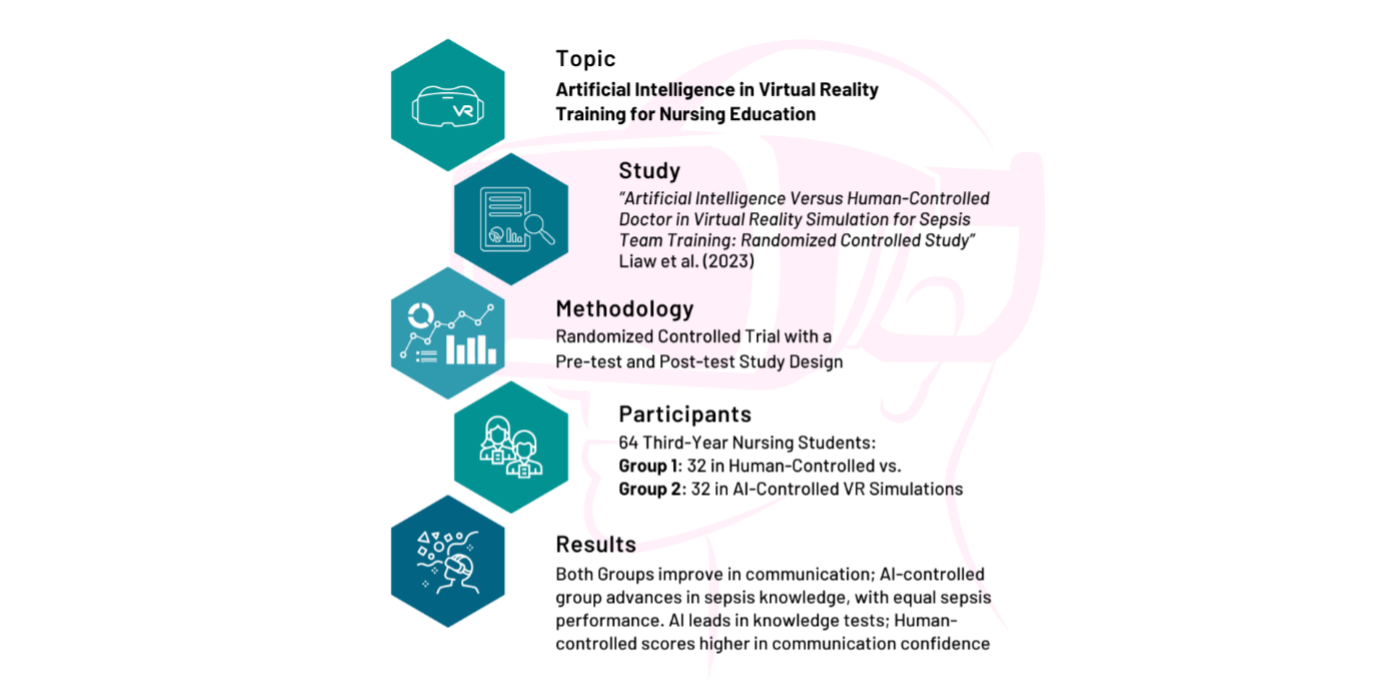Revolutionizing Nursing Education: AI's Emergent Role in Virtual Reality Simulations
As technology use in nursing and medical education expands, new opportunities open up, incorporating artificial intelligence (AI) and virtual reality (VR) into clinical simulation training (1). With VR technology becoming more affordable, its integration into healthcare education is increasingly feasible, offering cost-effective solutions for complex training scenarios in nursing education, such as disaster training, decontamination skills, or maternal-newborn nursing (1, 2).
VR can simulate clinical environments for healthcare education, from screen-based or immersive experiences to mirroring real-life training scenarios. Its simulators can capture tool movements, thus generating large datasets that can be analyzed with machine learning algorithms (3). Therefore, integrated with AI, VR can enhance personalized learning, identify knowledge gaps, support teachers, and tailor education (4).
Study investigates AI-powered vs. human-controlled virtual doctors in VR settings
Liaw et al. (2023) explore AI integration by comparing the effectiveness of AI-controlled virtual doctors and human-controlled virtual avatars for training in VR settings. The variables studied in the experiment were sepsis care knowledge, communication skills, and self-efficacy among nursing students. They conducted a randomized controlled trial involving 64 participants who received either AI or human-led training, with pre- and post-training evaluations to measure progress (5).

The VR simulations replicated high-stakes interprofessional clinical scenarios, demanding timely diagnosis and management of sepsis alongside efficient team communication. Both AI- and human-led training significantly improved communication skills and self-confidence. However, the AI-powered group exhibited a significantly greater enhancement in sepsis care knowledge, while the human-led group reported higher self-efficacy in interprofessional communication (5).
Necessity for advancements in Human-AI social interactions
The participants in the human-controlled group, unlike those in the AI-powered groups, had opportunities for social interactions through role-playing and debriefing sessions. Despite efforts to improve the AI doctor’s facial expressions and conversational understanding, achieving realistic human-AI interactions remains challenging (5). Nevertheless, AI-powered VR training effectively improves knowledge, as further supported by qualitative data where nursing students viewed the AI doctor as more knowledgeable than its human-operated counterpart (6).
Investing in VR Education: Long-term benefits outweigh initial costs
Besides AI/VR’s shown benefits and qualitative effectiveness in nursing education, considering its economic impact on healthcare training is crucial. Key considerations for its economic viability include • the longevity and scalability of training programs, • cost distribution among trainees or staff, hence lowering costs per user, and • comparative analysis against traditional training methods‘ ongoing costs and logistical challenges (2).
VR training becomes more economical per participant due to its scalability and reduced marginal costs for additional training sessions when amortized over the years. Its long-term cost-efficiency, coupled with its effectiveness in enhancing learning outcomes, solidifies its value as a high-quality educational tool in healthcare (2).
Concluding remarks
AI-driven VR simulations offer an innovative method for continuous medical training, notably enhancing knowledge and communication skills in complex clinical situations like sepsis care. While there is room for improvement in human-AI social interaction, AI-powered doctors have already outperformed human-controlled agents in knowledge enhancement. The study’s findings highlight AI’s substantial potential to enrich nursing education, further positioning VR as a potentially cost-effective and high quality alternative to traditional training methods.
Further readings: Leveling Up Healthcare Education: A Lucrative Opportunity for Investors and Health Entrepreneurs in Serious Games and Gamification
Kontakt
E-Mail:
atlas-itg@uni-wh.deInnovation im Gesundheitswesen
Alfred-Herrhausen-Straße 50
58448 Witten, Deutschland

